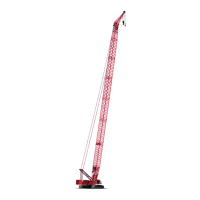INTRODUCTION 16000 SERVICE/MAINTENANCE MANUAL
1-26
Published 05-03-17, Control # 228-03
TRAVEL SYSTEM OPERATION
See Figure 1-15 and Figure 1-16. Each travel hydraulic
pump drives a crawler system motor and gearbox. Each
hydraulic pump and motor is controlled with the travel control
handle movement and node controllers. The travel control
handles are inoperable when the travel park brake is applied.
The gearbox for each crawler is driven with a flexible shaft
connected between the motor output and drive gearbox
input.
The left travel pump is dedicated to operate drum 3 through a
diverting valve if drum 3 is selected. The right travel pump is
dedicated to operate drum 4 through a diverting valve if drum
4 is selected under certain conditions when drum 5 is also
configured.
To ensure that the crane travels in a straight line in forward
and reverse direction, each travel drive system has shuttle
valves and pressure senders in each leg that monitor
hydraulic pressure. When traveling, the Node-4 controller
monitors pressure information from the pressure senders
and adjusts the displacement of travel pumps to maintain
equal pressure in each travel drive system.
The source of hydraulic pressure for releasing the travel
brakes and enabling motor servo systems is from the
accessory/MAX-ER pump at 35 bar (508 psi). Continuous
changing of closed-loop fluid occurs through leakage in the
pump, motor, and loop flushing valves that removes 19 Lpm
(5 gpm) of fluid when the system pressure is above 14 bar
(203 psi).
The travel pumps output can be programmed for 25% to
100% of rated volume on the Function Mode screen—see
Section 3.
When either the travel control handle is moved from off, an
input signal is sent to the Node-1 controller. The Node-3 and
5 controllers send a 24 volt signal to enable the rear and right
side swing/travel alarms. When both the travel control
handles are moved to off, an input signal is sent to the Node-
1 controller. The Node-3 and 5 controllers send a zero volt
output signal to disable the rear and right side swing/travel
alarms.
Travel Brakes
Hydraulic pressure for releasing the travel brakes is output
pressure from the accessory/MAX-ER pump at 28 to 35 bar
(406 to 508 psi). For travel brake operation the system
pressure must be above 14 bar (203 psi) for the brakes to
release from each travel motor shaft. If the system pressure
is below 14 bar (203 psi), the travel brake could be partially
applied and damage the brake. If brake pressure or electrical
power is lost when operating, the travel brakes apply.
When travel brake switch is in the ON-park position, the right
and left travel brakes are applied to hold crane in position.
The travel brake valve is open to allow hydraulic flow from
the brake to the tank.
When the travel brake switch is in the OFF-park position, an
input signal is sent to the Node-1 controller. The travel
system circuit is enabled, waiting for a travel control handle
command. When the travel control handle is moved an input
signal is sent to the Node-1 controller. The Node-5 controller
sends a 24 volt output to enable the travel brake release
solenoid HS-5. The brake valve shifts to block the tank port
and supplies the low pressure hydraulic fluid from the
accessory/MAX-ER pump to release the crawler brakes. If
brake pressure or electrical power is lost when operating, the
brakes apply.
Travel Forward and Reverse
When a travel control handle is moved in the forward
direction, an input voltage of 2.6 volts or more is sent to the
Node-1 controller. The Node-3 controller sends a variable 0
to 24 volt output that is divided by a resistor and applied to
the selected travel pump EDC. The Node-5 controller sends
a 24 volt output to enable the travel brake release solenoid
HS-5 and release both the left and right crawler brakes,
before the travel pump(s) strokes.
The travel pump EDC tilts the pump swashplate in the
forward direction. Hydraulic fluid flow is from the selected
pump ports through the swivel to the motor ports. The Node-
3 controller input voltage to the travel pump EDC is relative
to the control handle movement.
When a travel control handle is moved in the reverse
direction, an input voltage of 2.4 volts or less is sent to the
Node-1 controller. The Node-3 controller sends a variable 0
to 24 volt output that is divided by a resistor and applied to
the selected travel pump EDC. The Node-5 controller sends
a 24 volt output to enable the travel brake solenoid HS-5 and
release both crawler brakes, before the pump(s) strokes.
The travel pump EDC tilts the pump swashplate in the
reverse direction. Hydraulic fluid flow is from the selected
pump ports through the swivel to the motor ports. The Node-
3 controller input voltage to the selected travel pump EDC is
relative to the selected control handle movement.
FIGURE 1-15
HS-14
HS-5
HS-6
HS-28
Brake
Pressure
Sender
Diverting
Valve
Accessory Pump
(Low-Pressure)
Pressure
Sender
Motor
(PCP)
Pump
(EDC)
16-1010
Diverting
Valve
Pressure
Sender
Pressure
Sender
Pump
(EDC)
2-Speed

